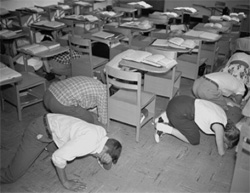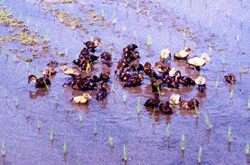I grew up in the 1950s. During my childhood in the post-World War II nuclear arms race between the world’s superpowers USA and USSR, at my elementary school we learned to “duck and cover” (see http://wn.com/Duck_And_Cover_1951_Bert_The_Turtle_Civil_Defense_Film) under our desks in our classrooms to safeguard us from a nuclear attack. Families were advised to construct underground fallout shelters stocked with sufficient bottled water and canned food until the “all clear sirens” announced it was safe to emerge after a nuclear incident.
 Spawned from US President Dwight Eisenhower´s “Atoms for Peace” address to the General Assembly of the United Nations on 8 December 1953, the “Atoms for Peace” Program (subsequently becoming the International Atomic Energy Agency) was established in 1957 (see http://www.iaea.org/About/history_speech.html). Twenty years later, Amory Lovins, internationally renowned energy expert and author of Soft Energy Paths: Toward a Durable Peace (1977), argued that nuclear power is too expensive, unnecessary, and dangerous, and should be abandoned to invest in a renewable energy future. Now forty years later, in the wake of nuclear accidents at Three Mile Island (1979) in the USA and at Chernobyl (1986) in the USSR, the tsunami-damaged Fukushima Daiichi nuclear power plant in Japan poses a dire threat of radiation release and contamination. On 18 March 2011 Lovins again sounded his clarion call to abandon expensive, unnecessary, and dangerous nuclear energy technology for renewable solar energy options (see http://www.huffingtonpost.com/amory-lovins/nuclear-power-fukushima-_b_837643.html). If it looks like a duck…..
Spawned from US President Dwight Eisenhower´s “Atoms for Peace” address to the General Assembly of the United Nations on 8 December 1953, the “Atoms for Peace” Program (subsequently becoming the International Atomic Energy Agency) was established in 1957 (see http://www.iaea.org/About/history_speech.html). Twenty years later, Amory Lovins, internationally renowned energy expert and author of Soft Energy Paths: Toward a Durable Peace (1977), argued that nuclear power is too expensive, unnecessary, and dangerous, and should be abandoned to invest in a renewable energy future. Now forty years later, in the wake of nuclear accidents at Three Mile Island (1979) in the USA and at Chernobyl (1986) in the USSR, the tsunami-damaged Fukushima Daiichi nuclear power plant in Japan poses a dire threat of radiation release and contamination. On 18 March 2011 Lovins again sounded his clarion call to abandon expensive, unnecessary, and dangerous nuclear energy technology for renewable solar energy options (see http://www.huffingtonpost.com/amory-lovins/nuclear-power-fukushima-_b_837643.html). If it looks like a duck…..
My heart goes out to Japanese families and friends of victims of the 14 March 2011 tsunami that claimed thousands of lives. I feel great angst, sympathy, gratitude, and respect for the brave Japanese first responders engaged in ongoing damage control and containment of the radioactive Fukushima nuclear power plant. Their acute exposure to radioactivity may result in more morbidity and mortality in attempts to safeguard their fellow Japanese citizens and others from further peril. I have Japanese friends that live on Kyushu island in southern Japan away from the current disaster zone, but depending on wind conditions, I am fearful they could be exposed to radioactivity at some point.
The International Atomic Energy Agency is monitoring radiation levels in cooperation with Japanese officials on site and at distances up to 73 km west of the Fukushima nuclear power facility, and a second IAEA monitoring team started work on 24 March 2011 in Fukushima and Tokyo. Measurements will be taken to determine more precisely the actual radionuclides that have been deposited. IAEA summarizes that radioactivity in the environment, foodstuffs and water is moving more to the forefront, as some technical concerns related to the status of the reactors at the Fukushima Daiichi site appear to be slightly less acute in some respects. However, the overall situation on the Fukushima site remains very serious (for radiation levels, see http://www.iaea.org/newscenter/news/tsunamiupdate01.html).
 On Shikoku, another southern island of Japan, Masanobu Fukuoka quietly led by example for over six decades a natural farming movement based on organic methods akin to Permaculture. In The One-Straw Revolution (1975), he explained how mimicking Nature as our best teacher can provide bounteous food while restoring health to the land and people. One component in his integrated agroecosystem approach are ducks that eat slugs and deposit nitrogen-rich fertilizer in the rice paddy fields, as well as provide high-protein eggs and meat.
On Shikoku, another southern island of Japan, Masanobu Fukuoka quietly led by example for over six decades a natural farming movement based on organic methods akin to Permaculture. In The One-Straw Revolution (1975), he explained how mimicking Nature as our best teacher can provide bounteous food while restoring health to the land and people. One component in his integrated agroecosystem approach are ducks that eat slugs and deposit nitrogen-rich fertilizer in the rice paddy fields, as well as provide high-protein eggs and meat.
Sensei (teacher) Fukuoka writes, “To provide animal manure to help decompose the straw, I used to let ducks loose in the fields. If they are introduced as ducklings—while the seedlings are still young—the ducks will grow up together with the rice. Ten ducks will supply all the manure necessary for a quarter acre of land and will also help to control weeds. Using straw, green manure, and a little poultry manure, one can get high yields without adding compost or commercial fertilizer at all. For several decades now, I have been sitting back, observing Nature’s method of cultivation and fertilization. And while watching, I have been reaping bumper crops of vegetables, citrus, rice, and winter grain—as a gift, so to speak—from the natural fertility of the Earth!” Ducks are part of the solution for a sustainable future operating in a web of life powered by solar energy. The great grandfather of natural farming in Japan, Fukuoka died in 2008 at the ripe old age of 95.
Healthy ducks, healthy humans,

Prof. Victor D. Phillips, GEM Director
